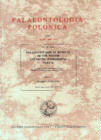| PALAEONTOLOGIA POLONICA VOL. 63 | |
 |
Guest editor: Grzegorz Racki Editor: Jerzy Dzik Assistant editor: Wojciech Majewski |
Jerzy
DZIK |
Abstract: The
stratigraphically complete and extremely fossiliferous geological sections in
the Holy Cross Mountains and Sudetes, Poland, cover the whole history of the
Famennian tropical high-diversity pelagic ecosystem. Apparatus reconstruction of
142 conodont species allowed paleobiological interpretation of the faunal
succession. Three families, nine genera and 39 species are newly proposed. 76
species of goniatites, with one genus and five species new, and 70 species of
clymenias were also identified. Like in all other equatorial localities, a
significant (but not catastrophic) decline of diversity marks the beginning of
the Famennian. The local pelagic fauna developed mostly as a result of
successive reappearances of lineages earlier occurring in the area but
temporally removed from it by environmental factors. During the whole Famennian,
101 immigrations of conodont lineages are documented. In 31 of the lineages
persisting in the area a more or less complete record of their phyletic
evolution is represented; they cover about half (46%) of the summarized ranges
of all the lineages. About half of them are suitable for stratophenetic studies.
The fossil record of the ammonoids is much more punctuated, but it is estimated
that 110 lineages was represented there, only 14 of them possibly evolving
phyletically in the area (single case was stratophenetically proven). At the
transition between goniatites and clymenias, a succession within the plexus of
closely related sympatric species is observed, but the exact phyletic change is
not recorded and probably all the first clymenias are immigrants from the east.
At least two profound rebuildings of the fauna within the Famennian are observed,
but only the terminal Devonian Hangenberg event was of truly dramatic nature.
The newly acquired evidence supports the earlier notion thate it is more
difficult to trace evolution stratophenetically in the equatorial regions than
in high latitudes.
Key words: Conodonta, Devonian, apparatuses, evolution, Holy Cross Mountains, Poland. Jerzy Dzik [dzik@twarda.pan.pl], Instytut Paleobiologii PAN, Twarda 51/55, PL-00-818 Warszawa and Instytut Zoologii Uniwersytetu Warszawskiego, Banacha 2, PL-02-079 Warszawa, Poland. Received 20 November 2005,
accepted 3 November 2006
|
Home | Editors | Current Issue | Archive | Instructions | Subscription | History | Institute of Paleobiologyy |
|
| ©
1997-2006. Instytut Paleobiologii PAN Web Site Design by Jarosław Stolarski Last updated 06-12-28 |
Best
viewed by Internet Exlorer 4.x or higher and |